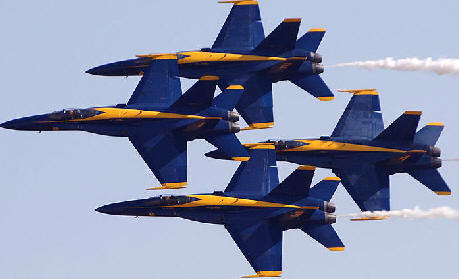
NEWSROOM
 |
NEWSROOM |
|
|
|
|
|||
|
By Daniel Guevarra |
||||
 |
December 8, 2009 - Vectren Dayton Air Show officials have learned that the world renowned US Navy Blue Angels will appear at the 2010 Vectren Dayton Air Show Presented by Kroger on July 17th and 18th.
The announcement was made at the International Council of Air Shows’
annual convention in Performing at 35 show sites during the season, the Blue Angels have been seen by over 400 million spectators since their first demonstration in 1946. Thrilling audiences for over 60 years, the Blue Angels fly six powerful F/A–18 Hornets during their tightly choreographed, high-energy demonstration. |
|||
|
New to
Also added to the lineup is Greg Poe, who will put his new Fagen
ethanol-powered MX-2 monoplane through its paces with exhilarating
aerobatic maneuvers. A world record holder in multiple aerobatic
categories, Greg has also been featured on television on such shows as
Modern Marvels, Ripley’s Believe it or Not, and The Discovery Channel.
The United States Navy's Navy Flight Demonstration Squadron, popularly
known as the Blue Angels, first performed in 1946 and is currently the
oldest flying aerobatic team. The squadron's six demonstration pilots
fly the Boeing F/A-18 Hornet in more than 70 shows at 34 locations
throughout the |
||||
|
The Blue Angels show season runs each year from March until November.
They perform at military and civilian airfields, and often perform
directly over major cities such as
The Solos fly many of their maneuvers just under the speed of sound,
showcasing the high performance capabilities of their individual Hornets
through the execution of high-speed passes, slow passes, fast rolls,
slow rolls, and very tight turns. Some of the maneuvers include both
solo F/A-18s performing at once, such as opposing passes (toward each
other in what appears to be a collision course) and mirror formations
(back-to-back. belly-to-belly, or wingtip-to-wingtip, with one jet
flying inverted). The Solos join the Diamond near the end of the show
for a number of maneuvers in the Delta formation.
The parameters of each show must be tailored to local weather: in clear
weather the "high" show is performed; in overcast conditions a "low"
show is performed, and in limited visibility (weather permitting) the
"flat" show is presented. The "high" show requires an 8,000-foot (2,400
m) ceiling and visibility of 3 nautical miles (6 km) from the show's
centerpoint. "Low" and "flat" ceilings are 3,500 and 1,500 feet (460 m)
respectively.
When initially formed, the unit was called the Navy Flight Exhibition
Team. The squadron was officially redesignated as the United States Navy
Flight Demonstration Squadron in December 1974. The original team
adopted the nickname Blue Angels in 1946, when one of them came across
the name of
The official Blue Angels insignia was designed by then team leader Lt.
Cmdr. R.E. "Dusty" Rhodes and approved by CNO in 1949. It is nearly
identical to the current design. In the cloud in the upper right
quadrant, the aircraft were originally shown heading down and to the
right. Over the years, the plane silhouettes have changed along with the
squadron's aircraft. Additionally, the lower left quadrant, which
contains the Chief of Naval Air Training insignia, has occasionally
contained only Naval Aviator wings.
Originally, demonstration aircraft were navy blue (nearly black) with
gold lettering. The current shades of blue and yellow were adopted when
the team transitioned to the Bearcat in 1946. For a single year in 1949,
the team performed in a blinding all-yellow scheme with blue markings.
The current paint scheme, including yellow stripe markings along the top
of the fuselage, and "U.S. Navy" on the bottom of the wings, was
designed by team member Robert L. Rasmussen in 1957. |
| ©AvStop Online Magazine Contact Us Return To News |
|